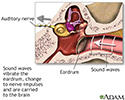Waardenburg syndrome
Klein-Waardenburg syndrome; Waardenburg-Shah syndrome
Waardenburg syndrome is a group of conditions passed down through families. The syndrome involves deafness and pale skin, hair, and eye color.
Deafness
Hearing loss is being partly or totally unable to hear sound in one or both ears.

Causes
Waardenburg syndrome is most often inherited as an autosomal dominant trait. This means only one parent has to pass on the faulty gene for a child to be affected.
Autosomal dominant
Autosomal dominant is one of several ways that a trait or disorder can be passed down (inherited) through families. In an autosomal dominant disease,...

There are 4 main types of Waardenburg syndrome. The most common are type I and type II.
Type III (Klein-Waardenburg syndrome) and type IV (Waardenburg-Shah syndrome) are rarer.
The multiple types of this syndrome result from defects in different genes. Most people with this disease have a parent with the disease, but the symptoms in the parent can be quite different from those in the child.
Symptoms
Symptoms may include:
- Cleft lip (rare)
- Constipation
- Deafness (more common in type II disease)
-
Extremely pale blue eyes or eye colors that don't match (
heterochromia
)
Heterochromia
Heterochromia is different colored eyes in the same person.
 ImageRead Article Now Book Mark Article
ImageRead Article Now Book Mark Article - Pale color skin, hair, and eyes (partial albinism)
- Difficulty completely straightening joints
- Possible slight decrease in intellectual function
- Wide-set eyes (in type I)
- White patch of hair or early graying of the hair
Less common types of this disease may cause problems with the arms or intestines.
Exams and Tests
Tests may include:
-
Audiometry
Audiometry
An audiometry exam tests your ability to hear sounds. Sounds vary, based on their loudness (intensity) and the speed of sound wave vibrations (tone)...
 ImageRead Article Now Book Mark Article
ImageRead Article Now Book Mark Article -
Bowel transit time
Bowel transit time
Bowel transit time refers to how long it takes for the food to move from the mouth to the end of the intestine (anus). This article talks about the m...
 ImageRead Article Now Book Mark Article
ImageRead Article Now Book Mark Article - Colon biopsy
- Genetic testing
Treatment
There is no specific treatment. Symptoms will be treated as needed. Special diets and medicines to keep the bowel moving are prescribed to those people who have constipation. Hearing should be checked closely.
Outlook (Prognosis)
Once hearing problems are corrected, most people with this syndrome should be able to lead a normal life. Those with rarer forms of the syndrome may have other complications.
Possible Complications
Complications may include:
- Constipation severe enough to require part of large bowel to be removed
- Hearing loss
- Self-esteem problems, or other problems related to appearance
- Slight decreased intellectual functioning (possible, unusual)
- Slight increased risk for muscle tumor called rhabdomyosarcoma
When to Contact a Medical Professional
Genetic counseling may be helpful if you have a family history of Waardenburg syndrome and plan to have children. Call for a hearing test if you or your child has deafness or decreased hearing.
References
Milunsky JM. Waardenburg syndrome type I. GeneReviews . Seattle WA: University of Washington; 2014:8. Accessed August 1, 2015. PMID: 20301703 www.ncbi.nlm.nih.gov/pubmed/20301703 .
-
Broad nasal bridge - illustration
Broad nasal bridge, or widening of the base of the nose, is a relative term. It can be a normal facial feature, but it can also be associated with certain congenital disorders such as basal cell nevus syndrome, or trisomy 8, a chromosome defect.
Broad nasal bridge
illustration
-
Sense of hearing - illustration
Sound waves travel from the external ear to the middle ear, pass through the eardrum and enter the inner ear where they are interpreted and communicate with neural structures.
Sense of hearing
illustration
-
Broad nasal bridge - illustration
Broad nasal bridge, or widening of the base of the nose, is a relative term. It can be a normal facial feature, but it can also be associated with certain congenital disorders such as basal cell nevus syndrome, or trisomy 8, a chromosome defect.
Broad nasal bridge
illustration
-
Sense of hearing - illustration
Sound waves travel from the external ear to the middle ear, pass through the eardrum and enter the inner ear where they are interpreted and communicate with neural structures.
Sense of hearing
illustration
Review Date: 8/1/2015
Reviewed By: Chad Haldeman-Englert, MD, FACMG, Fullerton Genetics Center, Asheville, NC. Review provided by VeriMed Healthcare Network. Also reviewed by David Zieve, MD, MHA, Isla Ogilvie, PhD, and the A.D.A.M. Editorial team.


